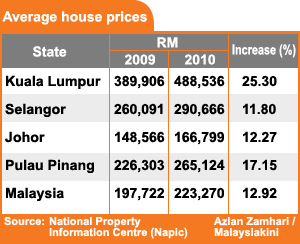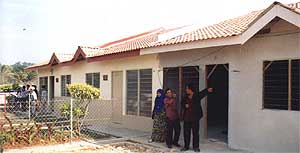SPECIAL REPORT While wages have remained more or less static in 2010, the property industry was celebrating what it deemed to be a year of robust growth.
According to the National Property Information Centre (Napic), average prices of residential property in Malaysia rose by about 12 percent in 2010 to about RM 220,000 compared with the year before.
 Houses in the Klang Valley alone cost RM100,000 more than in 2009.
Houses in the Klang Valley alone cost RM100,000 more than in 2009.
International consultant company Robert Walters found that on top of stagnant wages, bonuses in 2010 were also lower than in 2009.
In 2009, professionals with less than five years of working experience could expect to earn under RM5,000 a month on average, depending on the industry.
And so was born the sandwich class - a generation of Malaysians who, despite receiving better education, training and opportunities than their predecessors - are taking home salaries insufficient to open them to the property market.
While the property price hike in 2010 represented a big jump, Napic data show that prices have been on a steady rise since 2000, when average house prices were about 40 percent lower nationwide.
Speculative buying driving prices up
According to National House Buyers' Association (NHBA) official Tan Chong Leng, the hike in residential property prices has been due to speculative buying.
 "When the government waived the real property gains tax (RPGT) following the economic crisis, it sparked speculative activities that increased house prices higher and higher," Tan said.
"When the government waived the real property gains tax (RPGT) following the economic crisis, it sparked speculative activities that increased house prices higher and higher," Tan said.
The RPGT prior to 2007 was 30 percent for those who sell off their properties within a year of purchase.
It was reintroduced at five percent in mid-2009 by what analysts deemed to be a ‘cash-strapped' government, but only for sale within five years of purchase after protests from the real estate industry.
Tan, who is in charge of the Chinese unit of the NHBA, said the government should look into imposing a progressive RPGT, with the rates increasing with the numbers of property purchased.
Amid fears of a property bubble burst, Bank Negara Malaysia has also limited buyers of their third property to a 70 percent loan to value ratio to curb speculation - a figure consumer associations say should be even lower.
Developers fleecing house buyers?
NHBA has also been very vocal in its claim that developers are riding the wave to fleece house buyers.
"The developers earn very high profits. When a luxury property project is launched, there will only be a few units available, bumping up demand so that other units are sold later at a higher price, usually at a second launch," said Tan.
Figures from developers may will prove that Tan is not too far from the truth.
In an interview with BFM Radio on Wednesday, property developer Land and General Bhd's general manager Low Gay Teck admitted to steep margin gains, particularly in the Klang Valley.
Low said the company had purchased land in Sri Damansara for RM20 a square foot, only to develop properties now retailing at a "conservative" tag of RM400 a square foot.
Other developers, such as Sunway Holdings and Sunway Bhd, have profit margins reportedly ranging from 15 percent to 35 percent for condominium units.
 But for Ho Wen Yen, chief executive officer of Hua Yang Bhd, which aims to be the top developer of affordable housing in the nation, prices only reflect demand-and-supply interactions.
But for Ho Wen Yen, chief executive officer of Hua Yang Bhd, which aims to be the top developer of affordable housing in the nation, prices only reflect demand-and-supply interactions.
"There has always been demand for affordable housing. Our population is increasing at 2.3 to 2.7 percent every year and young families need a place to grow," Ho said, adding that multiple property purchases were more for ‘investment', not ‘speculation'.
High demand, he said, was pushing prices up because developers could not keep up with supplying houses, particularly affordable units.
With Napic data showing some 67,000 units of luxury condominiums unsold at the end of 2010, it appears that developers are not focusing on affordable housing.
However, Ho said it is "not fair" to blame developers for the lack of affordable housing as "the private sector has adhered to the 30 percent low-cost housing quota" set for it.
Rising cost of construction
In any case, the Real Estate Housing & Housing Developers' Association (Rehda) has warned that construction prices will bump terrace houses in Kuala Lumpur beyond RM400,000 a unit, compared with the average price of RM290,000 nationwide.
According to the Construction Industry Development Board, costs of construction materials such as sand and cement have increased by about 10 percent on average in the past year.
 Rehda estimates that prices of steel bars increased by 40 percent last year, to a whopping RM2,580 a tonne.
Rehda estimates that prices of steel bars increased by 40 percent last year, to a whopping RM2,580 a tonne.
Labour costs, according to CIDB, have risen by about RM10 a day and this, Ho said, would impact developers significantly as much of the industry is reliant on manual labour and not on industrialised building systems (IBS).
Industry players estimate that the average cost of construction will be around RM150 a square foot, depending on the quality of finishing.
"This means that the construction cost alone for a normal terrace house, excluding the cost of land, will come to about RM270,000. A medium to lower cost unit will cost RM110,000 to build," said a quantity surveyor who cannot be named as he is associated with a government body.
According to him, the only way for developers to keep prices down at current construction costs is to build outside the city, where land is cheaper.
Rehda estimates that land costs make up 20 percent of the total project development cost.
The quantity surveyor said what was promising for house buyers now was the government's announcement that it would give out land to developers under the Affordable Housing Programme, due to be launched within the next few months.
"But much of the land within city limits no longer belongs to the government, having been sold off to developers, so the houses under the programme would still probably be far (from the city centre)," he said.

